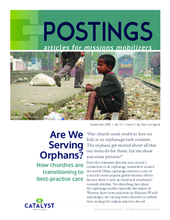Displaying 271 - 280 of 767
This study from the Institutionalised Children: Explorations and Beyond Special Issue on Aftercare describes the mental health outcomes and transition experiences of a group of young adults who are currently transitioning (aftercare) or have already transitioned (alumni) out of a residential care organisation for orphaned and separated children (OSC) in New Delhi, India.
This film from Lumos is about the people who know that there is an alternative to institutional care, and who are working hard to make it happen.
This article from the Institutionalised Children Explorations and Beyond Special Issue on Aftercare explores the outcomes for young people who have transitioned out of alternative care and into independent living in Sri Lanka and the need for policy changes to better meet their needs.
This article by Ellen Livingood in Volume 13, Issue 9 of Postings describes the ways in which Christian churches and faith communities are moving away from orphanage volunteering to supporting other forms of care for children.
This research compared the quality of life (QOL) of children and adolescents in Japan who live in Children’s Homes (CHs) with that of children and adolescents living in traditional families.
This article explores the impacts of two common forms of early childhood adversity, maltreatment and placement in institutional care, on children's behavioral, psychiatric, and physical health into adulthood.
The aim of this study was to assess the nutritional status of children residing at an orphanage.
The objective of the study was to assess the knowledge and practices regarding menstrual hygiene among adolescent girls residing in selected orphanages of Haryana.
This study examines the forms of abuse and neglect experienced by children living in orphanages in East Java Province, efforts by children in orphanages to deal with the acts of abuse experienced, and the role of the orphanage or the Child Social Welfare Institution (LKSA) in providing protection and fulfillment of the rights of abandoned children.
The current study from the Infant Mental Health Journal addressed whether two institution‐wide interventions in St. Petersburg, Russian Federation, that increased caregiver sensitivity (Training Only: TO) or both caregiver sensitivity and consistency (Training plus Structural Changes: T+SC) promoted better socioemotional and cognitive development than did a No Intervention (NoI) institution during the first year of life for children who were placed soon after birth.

